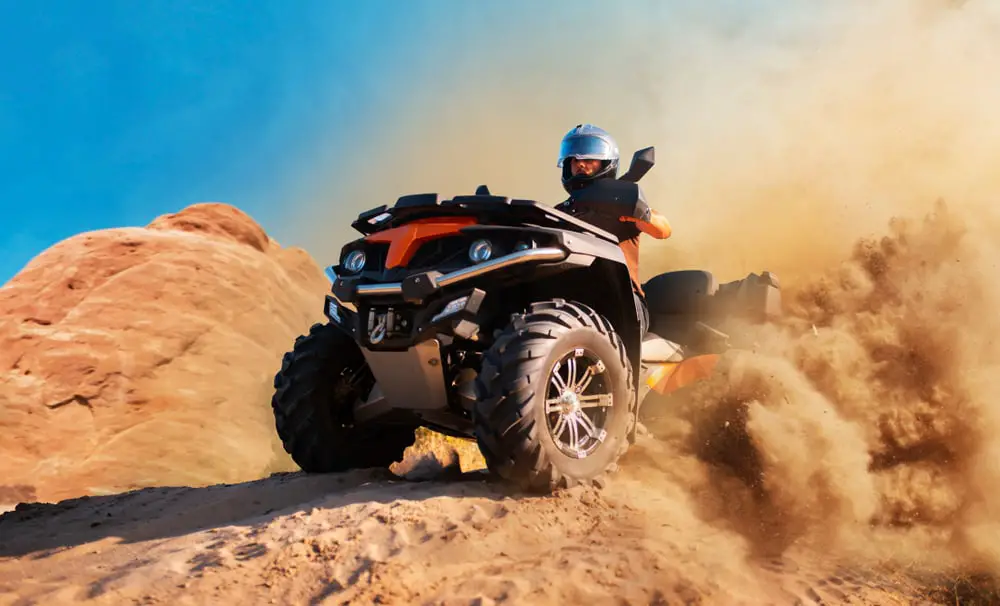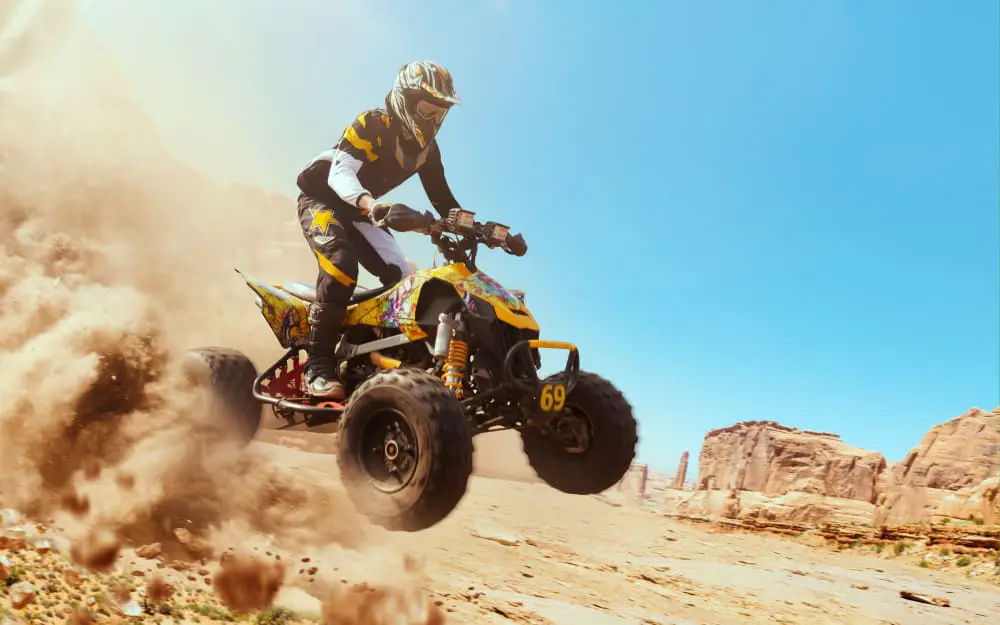
Riding an ATV on the sand at the beach or in the deserts is one of the best surfaces on which to enjoy the full capabilities of your ATV. These machines have been designed for the tough conditions posed by sandy, muddy and rocky off-road conditions. Sand consists of silicon dioxide, also known as quarts.
The mechanical breakdown of quarts rocks forms sand. The sand particles are crystalline and very hard. These small hard particles can cause a lot of damage to the much softer metal parts of an engine and drivetrain if the proper prevention and after use care is not taken.
The sand particles become even more destructive the smaller they are. The larger sand particles will get stuck to the chain and sprockets of the ATV or find their way into the brake pads and discs. If the sand is combined with oil, it will form a grinding paste that will damage all metal parts in contact. Why sand can be so detrimental to the metal parts of your ATV deserves some more attention.
The Hardness Of Sand Vs. Metal
Quartz crystals constitute the bulk of the mineral crystals, making up sand. On the Mohr Hardness Scale, diamond is the hardest substance and has a rating of 10. Quartz has a Mohr Hardness rating of 7, comparable only to Vanadium metal. Iron and aluminum have Mohr Harnesses of 4 and 3, respectively. Normal steel has a Mohr Hardness of 4.5 and high-carbon steel a hardness of 8.
The ATV engine is made of cast Aluminum, and the sleeve of the pistons of a thin layer of steel. The rings on the pistons are made of hardened steel. To ensure the optimal functioning of an internal combustion engine, oil is used as a lubricant.
The lubricating oil forms a thin layer between the metal of the piston and the metal of the piston sleeves. This thin film of oil prevents all metal-on-metal contact in the engine. The oil will prevent the metal parts from making contact and thus creating friction. The oil will circulate through the engine via the oil pump and oil filter to provide lubrication and remove dirt particles and other impurities caused by the combustion process.
The oil keeps the engine running cool and clean. When riding your ATV in the sand, the air filter is the most important barrier preventing sand and dust from being sucked into the engine’s combustion chamber. The combination of air filter, fuel filter, and oil filter work in unison to ensure that no dirt, sand, water, or soot accumulates in the oil.
Suppose sand was to bypass the air filter and mix with the oil in the engine. The sand particles would act like a scourer in the oil, causing the sand particles to scratch the surface of the piston walls and sleeve. The quartz in the sand is much harder than the aluminum of the steel components and would quickly wear these softer metals into suspension in the oil.
The oil would stop functioning as a lubricant and coolant and act as a grinding paste, quickly destroying the engine.
External components of the ATV such as the brake pads and discs, brake drums, drive chain, sprockets, the carburetor, or the fuel injection system can also be damaged by the ingress of sand particles.
However, there are steps we can take to prevent the potential damage caused by sand. The preventive measures will help to ensure long operational life while riding in sand and on muddy, dusty, or rocky surfaces.
Best Tires To Prevent Sand Rash
Sand blasting up from the ATV tires onto the metal and plastic surfaces is inevitable when riding on sandy surfaces. The tire pattern of ATV tires can dramatically influence the amount of sand kicked up by the tires.
Sand poses some unique challenges best understood by looking at ATV sand tire design in more detail. Rear tires have paddle-ridge patterns across the width of the tires, helping the tires to scoop through the soft sand.
The front tire design will have a longitudinal ridge down the tire’s centerline to assist the ATV in keeping a well-defined steering line. The job of the front tires is primarily to steer the ATV and not to kick back the sand, but rather part the sand to the sides, ensuring that very little sand is blown back onto the metal and plastic parts of the ATV, minimizing the effects of sand-blasting.
ATV sand tires are specialized for use on sand and would not provide optimal performance on other off-road surfaces like mud and rock.

Optimizing The Life Of Your ATV
To ensure that you get the best operational life out of your ATV, some preventative maintenance and a good checklist of items to check and maintain before and after every ride are essential.
A Clean Air Filter Is The Lungs Of Your ATV
Always ensure that you open the air-filter housing and check that the filter is clean. Using compressed air, blow off any dust or dirt on the filter. If the filter has been in use for a long time and exhibits any signs of damage, replace it with a new air filter.
Clean air is essential to the combustion process. If the air filter becomes blocked, the volume of air flowing to the combustion chambers will be less, resulting in a loss of power. Sand or dirt particles not captured by the air filter can cause a lot of damage to the engine.
Change The ATV Engine Oil Filter Regularly
Oil is the lifeblood of an engine. It helps lubricate the metal to metal surfaces, dissipates heat from the engine, and acts as a detergent to clean the engine’s internal components. The oil also prevents corrosion of metal components inside the engine.
Any impurities created during the combustion process will be carried away from the metal components by the oil. These impurities can be the soot caused by combustion or dirt in the fuel and air mixture. The oil filter will prevent these particles from flowing back into the engine.
In time, the oil becomes too dirty, and the oil filter will no longer clean the oil, hence the need to change the oil and the oil filter out frequently. The engine manufacturer will prescribe an oil service frequency during which these components must be replaced.
Operating the ATV in sandy, dusty or muddy conditions will hasten the need to conduct these oil services. Drain the oil, flush the engine with an engine flush, replace it with good quality oil and replace the oil filter.
Fuel Filter Checkup On An ATV
We assume that the fuel we fill up with at the gas station is perfectly clean. This is a wrong assumption. Even fresh fuel can be contaminated with water or dirt particles. The fuel system of your ATV is thus fitted with a fuel filter to catch dirt in the fuel.
Check the fuel filter during services when you replace the air filter, oil filter, and oil. Inspect the inside of your fuel tank for dirt ingress, and take note not to contaminate the fuel tank when filling up with gas.
Greasing Up The ATV
Check the owner’s manual on your ATV to determine the greasing points. Apply fresh grease after every excursion off-road. On an ATV, the most common grease points are pivot bolts, axle bearings, steering stem bushing, front hub bearings, and any other bushings and bearings identified in the owner’s manual.
The greased points will attract sand like a magnet during your ride. After thoroughly cleaning your ATV, re-grease all points with fresh grease and wipe the old grease away with a clean rag. You cannot over-grease your ATV!
ATV Post Sand Ride Valet and Maintenance Service
Your ATV was built to have fun with. In the process, it will get caked with sand, full of mud, ride through water and get disgustingly dirty. Give your ATV a thorough cleaning. Take care when using a pressure washer on your ATV engine and electronic components. Plug up all open cavities or apertures on the ATV with rags to prevent water ingress. Then you can pressure wash the worst of the mud, dirt, or sand off the wheels and chassis. Avoid spraying high-pressure water on the grease points, air intakes, or electrical components.
Once the worst dirt has been removed, use good-quality foam soap. You should use a three-component cleaning system consisting of foam wash soap, a cleaner degreaser, and a surface polish for painted and plastic components. Apply the foam wash to the ATV and use a paintbrush to agitate the foam into the hard-to-reach places. Rinse the ATV with fresh waste using a low-pressure garden hose.
Apply cleaner degreaser to areas with cakes oil, grease, and dirt. Wipe away as much of the dirt as possible with a clean towel. Use a soft microfiber towel to dry off the ATV and wipe away any stubborn dirt. Please have a good supply of microfiber towels and change them out for fresh cleans ones continuously.
Once clean and dry, apply the surface polish and shine up your ATV to look like new.
ATV Radiator Cleanliness and Maintenance
The radiator on your ATV is designed to help the coolant in the system to keep the engine cool during operation. If the radiator becomes clogged with sand or mud, it can no longer cool the engine and may lead to overheating, and overheating causes metal parts to distort and fail prematurely.
The coolant inside the radiator should also be regularly changed to ensure that it performs optimally. Radiator fluid is not expensive and well worth changing out often to ensure that your ATV runs cool and happy.
Fresh Fuel And A Clean Tank On An ATV
Fuel can attract moisture and dirt when the ATV is not in use. After long periods of storage, drain the fuel and rinse out the tank with fresh fuel. Now is a good time to check the fuel filter and replace it if required. Dirty fuel is the death of an engine. Ensure that the fuel, fuel tank, and fuel lines are clean.
Belt Drive Maintenance On An ATV
Many modern ATVs are designed with belt drives. If your ATV has a belt-driven Continuous Variable Transmission (CVT Drive), water, sand, and dirt ingress to this belt drive system will cause irreparable damage. Ensure that these CVT drives are properly cleaned and well maintained.
Axle Boot Maintenance On An ATV
Rubber boots protect the front and rear axle joints to prevent water and dirt from damaging the constant velocity joints. These boots can get worn or tear when riding in your ATV. Always check that the rubber CV joint boots are in good condition and do not allow water and dirt ingress to prevent catastrophic failure.
Conclusion
You should not be concerned about getting into the sand on your ATV. Your Quad bike was designed to play rough in the sand, mud, and dirt. Preparing your ATV before going on your sand adventure is important. Keeping the quartz crystals that comprise sand out of the engine is of primary concern.
Ensure that your ATV is well maintained and fitted with a clean air filter, oil filter, and fuel filters. A fresh tank of fuel and a good set of sand tires will ensure that your day on the beach or in the desert is fun-filled.
After your ride, a thorough ATV clean will ensure that all the sand is removed from the greased joints, air filter, engine, and radiator. During the cleaning and polishing, take note of any ATV underbody, engine and driveline components that show evidence of sand-rash. Re-grease all the grease points on the ATV. Also, consider applying protective decals or protective coatings to areas where sand-rash is unavoidable.
With proper care and maintenance, your ATV can give you many years of fun on the sand and always be in top form.


